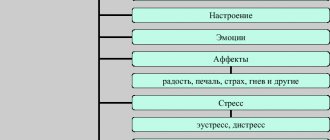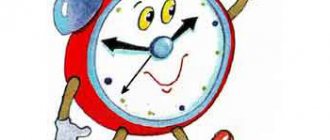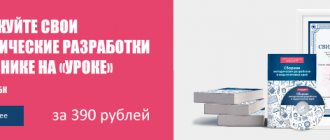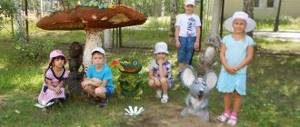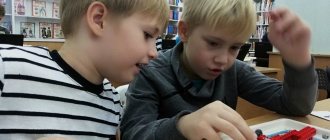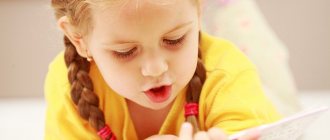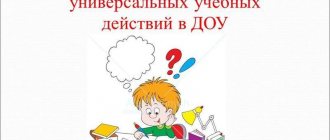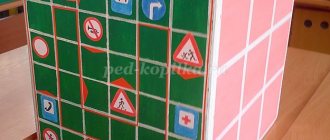Diagnostic card of a teacher-defectologist for the examination of children with mental retardation 6-7 years old
Equipment:
magnetic board, magnet (you can use some character, for example a bird).
Instructions:
“Look, it’s a bird, now it’s going on a journey. Place the bird on the top edge of the board, on the right side, on the left side, now he wants to walk at the bottom of the board.”
Result (we note how the child completed the task, what help was required during the task) ______________________________
- Orientation on landscape sheet (top/bottom, right/left side, center of sheet)
The examination is carried out similarly to the previous one.
Result (we note how the child completed the task, what help was required during the task) ______________________________
- Orientation on a sheet in a large cell (the concept of “cell”, you can circle a cell, put a dot in a cell)
Equipment:
sheet A4, which is lined in a checkered pattern, checkered size 3 cm by 3 cm, felt-tip pen.
Instructions:
“What are the names of the figures that you see on the sheet? Circle one cell. Place a dot inside any cell.”
Result (we note how the child completed the task, what help was required during the task) ______________________________
- Orientation on a sheet in a line (the concept of “line”, can draw a line in a line, show a line)
Result (we note how the child completed the task, what help was required during the task) ______________________________
Fine motor and graphomotor skills
h) Examination of fine motor skills
Leading hand (right/left) ___________________________________
- Ability to use scissors (cut a sheet of paper along drawn lines (straight, arched); cut a square).
Result (we note what the child was able to do, whether or not he knows how to use scissors)___________________________
- Ability to work with plasticine (tear off pieces, flatten, roll into flagella, balls, sculpt a simple object from 3 parts)
Result________________________________________________
- Ability to turn the pages of a book one at a time (the thickness of the page is equal to the thickness of the page)
Result________________________________________________
- Movement of individual fingers
- Presence of subtle differentiated movements
i) Graphomotor skills
- Ability to color a simple object drawing (large) without going beyond the outline
Result________________________________________________
- Ability to hold a pencil correctly (three-finger grip)
Result________________________________________________
- The ability to hatch large figures and simple objects (square, apple) inside the outline
Result________________________________________________
- Ability to trace a simple figure along the inner edge of a template (Montessori frames, such as a square)
- Result________________________________________________
- Ability to draw simple objects (house, tree, etc.)
Result (what the child can draw, attach a drawing) ________________________________________________
Level of formation of ideas about the phenomena of social life
Family
- Understand that the family is everyone who lives with the child.
- Know and be able to name close relatives.
Home country
- Know and name the city/town in which he lives
Adult labor
- Know the names of professions: driver, cook, salesman, doctor, teacher, as well as the content of work.
- Know your parents' place of work.
Questions for conversation:
- Tell me what city we live in?
- What is the name of the village in which we live?
- Tell us who your family consists of?
- How many people are in your family?
- How is your mother's name?
- What name of your father?
- What is your grandmother(s) name?
- What is your grandfather(s) name?
- What is your sister's (brother's) name?
- Who works in our group?
- What are the teachers' names?
- What is the name of the assistant teacher?
- Who monitors your health in kindergarten and how?
- What are the names of the nurse and doctor? Where is the medical office located?
- Who cooks your lunch and how?
- Where is the kitchen in the kindergarten?
Processing diagnostic results:
3 points – gives complete and correct answers, or gives complete and correct answers with minor errors.
2 points – incomplete answers, the presence in them, along with correct ideas, of a sufficient number of erroneous ones.
1 point – incomplete answers with a predominance of misconceptions, does not answer the questions.
Conclusion of a teacher-defectologist based on diagnostic results
- General information
Last name, first name ________________________________________________
Date of Birth ________________________________________________
Age ______________________________________________________
Address ________________________________________________________
- General information about the family
Information about parents (age, place of work, position)
Mother ______________________________________________________________
Father ______________________________________________________
Information about other children _____________________________________________
- Parental complaints ______________________________________________
- Results of psychological and pedagogical examination
Appearance of the child ________________________________________________
Accepting tasks _________________________________________________
Cooperation with adults (contact) __________________
Emotional response to the examination situation (no/is, what) _____________________________________________________
Cognitive development _____________________________________
Sensory development ________________________________________
Level of development of perception _________________________________
Chaotic actions___________trying actions___________
Trying on _____________ visual orientation__________
Level of development of visually effective thinking _________________________________________________________________
Level of development of visual and figurative thinking ______________
Level of development of elements of logical thinking _____________
Level of development of quantitative concepts _______________
Level of formation of ideas:
About the environment ______________ about yourself ___________________
About my family ___________________
About objects in the immediate environment __________________________
About natural phenomena and objects ______________________________
Level of game development ______________________________________________
Level of formation of productive activities:
Design by imitation ___________,
Drawing objects__________ according to the model __________story drawing_________.
Level of speech development:
Understanding verbal instructions______________________________
Methods of communication (emotional, business, speech) ___________
The presence and nature of phrasal speech ____________________________
- Conclusion
_____________________________________________
- Directions of correctional and developmental work_________
- Recommendations for specialists working with children_______
- Pedagogical forecast_______________________________________________
